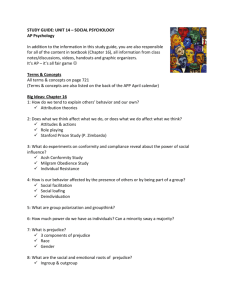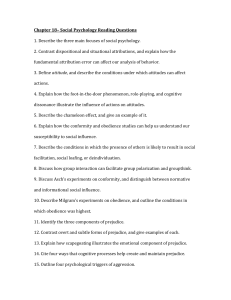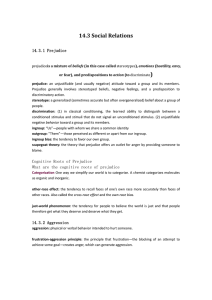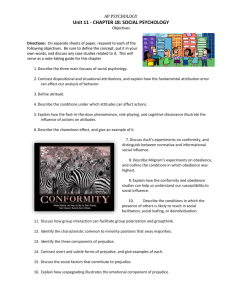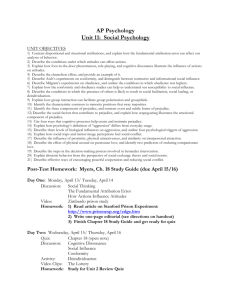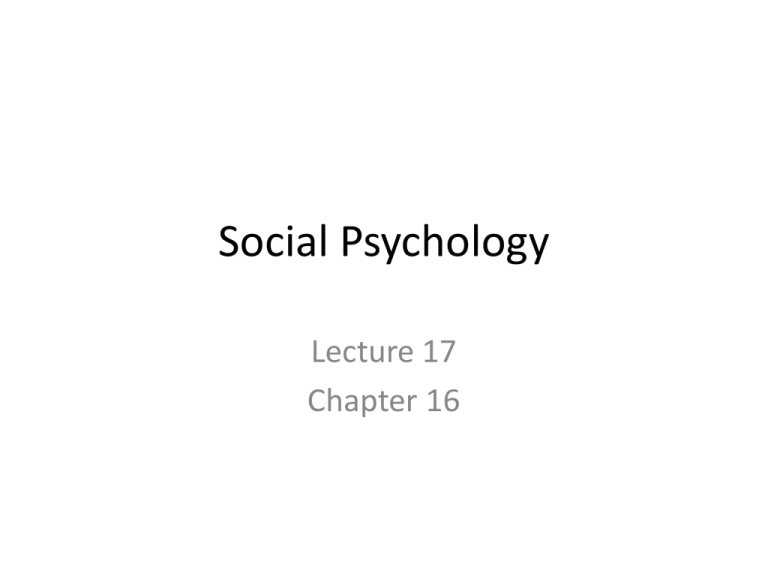
Social Psychology
Lecture 17
Chapter 16
Focuses in Social Psychology
“We cannot live for ourselves alone.”
Herman Melville
Social psychology scientifically studies how we think
about, influence, and relate to one another.
2
Social Thinking
1.
2.
Does his absenteeism signify illness, laziness, or a stressful work
atmosphere?
Was the horror of 9/11 the work of crazed evil people or ordinary
people corrupted by life events?
Social thinking involves thinking about others,
especially when they engage in doing things
that are unexpected.
3
Social Thinking
Attribution Theory
Attributing Behavior to
Persons or to Situations:
http://www.stedwards.edu
Fritz Heider
4
Social Thinking
How we explain someone’s behavior affects how
we react to it.
5
Social Thinking
Fundamental Attribution Error: tendency to
overestimate the impact of personal disposition
and underestimate the impact of the situations
on others
6
Attitudes and Actions
• Attitudes Can
Affect Actions
• Not only do
people stand for
what they believe
in (attitude), they
start believing in
what they stand
for.
7
Attitude and actions
Not only do people stand for what they believe in
(attitude), they start believing in what they stand
for.
D. MacDonald/ PhotoEdit
Cooperative actions can lead to mutual liking (beliefs).
8
Attitudes and Actions
9
Role Playing Affects Attitudes
Zimbardo (1972)
Originally published in the New Yorker
Phillip G. Zimbardo, Inc.
10
Social Influence
NON SEQUITER © 2000 Wiley. Dist. by Universal
Press Syndicate Reprinted with Permission
11
Group Pressure & Conformity
Suggestibility is a subtle type of conformity, adjusting our behavior or thinking
toward some group standard.
12
Group Pressure & Conformity
An influence resulting from one’s willingness to
accept others’ opinions about reality.
William Vandivert/ Scientific American
13
Conditions that Strengthen Conformity
1.
2.
3.
4.
5.
6.
7.
One is made to feel incompetent or insecure.
The group has at least three people.
The group is unanimous.
One admires the group’s status and
attractiveness.
One has no prior commitment to a response.
The group observes one’s behavior.
One’s culture strongly encourages respect for a
social standard.
14
Obedience
Courtesy of CUNY Graduate School and University Center
People comply to social pressures. How
would they respond to outright command?
Stanley Milgram designed a study that
investigates the effects of authority on
obedience.
Stanley Milgram
(1933-1984)
15
Obedience: Following Direct Orders
• Change in behavior in
response to the
commands of others
– Stanley Milgram’s
Obedience Study
– Why did people follow
the orders?
– What allows people to
feel irresponsible for
their actions?
Figure 2 of Module 44
Obediane: Milgram’s Study Results
17
Individual Resistance
A third of the individuals in Milgram’s study
resisted social coercion.
AP/ Wide World Photos
An unarmed individual single-handedly
challenged a line of tanks at Tiananmen Square.
18
Group Influence
How do groups affect our behavior? Social
psychologists study various groups:
1.
2.
3.
4.
One person affecting another
Families
Teams
Committees
19
Group Influence
Social facilitation:.
Michelle Agnis/ NYT Pictures
20
Group Influence
Social Loafing: The tendency of an individual in
a group to exert less effort toward attaining a
common goal than when tested individually
(Latané, 1981).
21
Group Influence
Deindividuation: The loss of self-awareness and
self-restraint in group situations that foster
arousal and anonymity.
Mob behavior
22
Group Influence
Group Polarization
23
Group Influence
Group Think:
Attack on Pearl Harbor
Kennedy and the Cuban Missile Crisis
Watergate Cover-up
Chernobyl Reactor Accident
• More likely if there is a clear leader and hierarchical
structure
• It is easier to agree than do the work it takes to form
your own opinion
• Entrapment – when disagreeing could cost too much
24
Power of Individuals
Margaret Bourke-White/ Life Magazine. © 1946 Time Warner, Inc.
Gandhi
25
Prejudice
Simply called “prejudgment,” a prejudice is an
unjustifiable (usually negative) attitude toward
a group and its members. Prejudice is often
directed towards different cultural, ethnic, or
gender groups.
Components of Prejudice
1.
2.
3.
Beliefs (stereotypes)
Emotions (hostility, envy, fear)
Predisposition to act (to discriminate)
26
How Prejudiced are People?
Over the duration of time many prejudices
against interracial marriage, gender,
homosexuality, and minorities have decreased.
27
Racial & Gender Prejudice
Americans today express much less racial and
gender prejudice, but prejudices still exist.
28
Prejudice
Although prejudice prevails against women, more people
feel positively toward women than men. Women rated
picture b [feminized] higher (66%) for a matrimonial ad
(Perrett & others, 1998).
Professor Dave Perrett, St. Andrews University
29
Prejudice
Prejudice develops when people have money,
power, and prestige, and others do not. Social
inequality increases prejudice.
30
Prejudice
Ingroup: People with whom one shares a
common identity. Outgroup: Those perceived as
different from one’s ingroup. Ingroup Bias: The
tendency to favor one’s own group.
Mike Hewitt/ Getty Images
Scotland’s famed “Tartan Army” fans.
31
Prejudice
Implicit testing (Hugenberg & Bodenhausen,
2003).
https://implicit.harvard.edu/implicit
32
Prejudice: Emotional roots
Prejudice provides an outlet for anger [emotion]
by providing someone to blame. After 9/11
many people lashed out against innocent
Arab-Americans.
33
Prejudice: Cognitive Roots
One way we simplify our world is to categorize.
We categorize people into groups by
stereotyping them.
Michael S. Yamashita/ Woodfin Camp Associates
Foreign sunbathers may think Balinese look alike.
34
Prejudice: Cognitive Roots
the just-world phenomenon
© The New Yorker Collection, 1981, Robert Mankoff from cartoonbank.com. All Rights Reserved.
35
Aggression
Genetic Influences: Animals have been bred for aggressiveness for sport and at
times for research. Twin studies show aggression may be genetic. In men, aggression
is possibly linked to the Y chromosome.
Neural Influences amygdala and the frontal lobe, are intimately involved with
aggression.
36
Aggression
Biochemical Influences: Testosterone
37
Aggression
Four psychological factors that influence aggressive behavior are:
1.
2.
3.
4.
dealing with aversive events;
learning aggression is rewarding;
observing models of aggression; and
acquiring social scripts.
38
Aggression
Studies in which animals and humans experience unpleasant events reveal that
those made miserable often make others miserable.
Jeff Kowalsky/ EPA/ Landov
Ron Artest (Pacers) attack on Detroit Pistons fans.
39
Summary
40
Attraction
1. Proximity: Repeated exposure to novel stimuli
increases their attraction (mere exposure
effect).
Rex USA
A rare white penguin born in a
zoo was accepted after 3
weeks by other penguins just
due to proximity.
41
Attraction
2. Physical Attractiveness: Once proximity
affords contact, the next most important thing
in attraction is physical appearance.
(Getty Images)
http://www.studentsoftheworld.info
42
Attraction
3. Similarity: Similar views among individuals
causes the bond of attraction to strengthen.
43
Altruism
An unselfish regard for the welfare of others.
44
Altruism: Bystander Intervention
The decision-making process for bystander
intervention.
Akos Szilvasi/ Stock, Boston
45
Altruism: Bystander Effect
Tendency of any given
bystander to be less
likely to give aid if other
bystanders are present.
46

